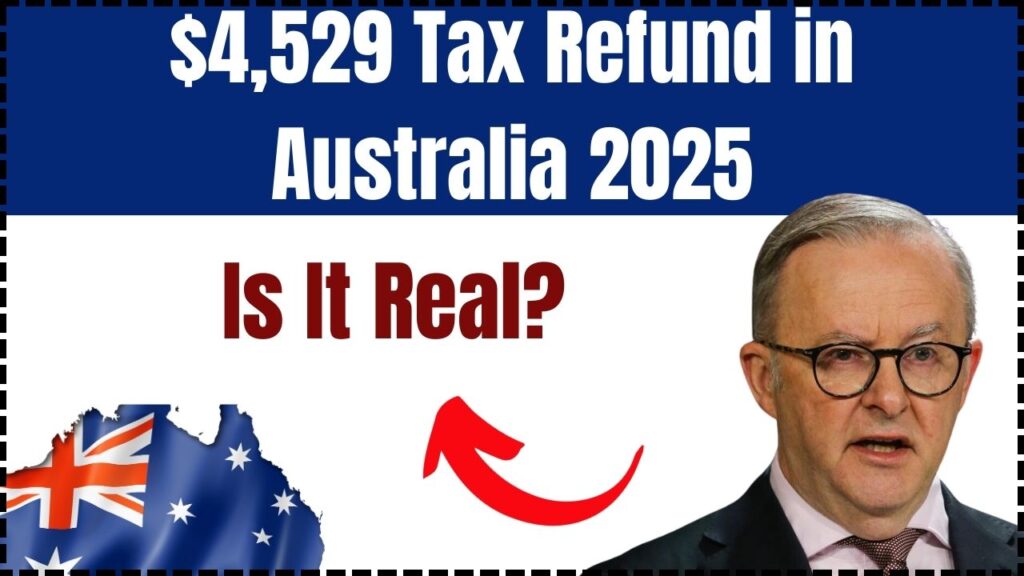$4,529 Tax Refund in Australia 2025: In 2025, many Australians are eager to know whether they will receive a $4,529 tax refund as part of recent tax changes. This figure has been widely circulated, leading to confusion about whether it’s an actual refund or a result of tax cuts. Let’s break down the facts, eligibility criteria, and how these tax changes impact different income levels.
$4,529 Tax Refund in Australia 2025
The $4,529 tax refund in Australia 2025 is not a direct refund but the maximum tax saving under the new Stage 3 tax cuts. While all taxpayers will benefit to some extent, only those earning $190,000+ will see the full $4,529 tax reduction. These changes increase take-home pay rather than provide a lump sum payout, helping Australians manage their finances better throughout the year.

| Aspect | Details |
|---|---|
| Tax Cut Implementation Date | 1 July 2024 |
| Beneficiaries | All Australian taxpayers, especially middle- and high-income earners |
| Maximum Tax Reduction | Up to $4,529 annually for individuals earning $190,000 or more |
| Eligibility Criteria | Australian residents for tax purposes with taxable income over $18,200 |
| Payment Mechanism | Reduction in tax withheld from salary; fully realized in annual tax return |
| Official Resource | Australian Taxation Office (ATO) |
What Is the $4,529 Tax Refund?
The widely discussed $4,529 figure refers to the maximum tax cut available under the Stage 3 tax reforms, effective from 1 July 2024.
This is not a direct refund, but a tax saving resulting from changes in the tax brackets. It means that high-income earners will pay less tax throughout the year, increasing their take-home salary.
Breakdown of the Stage 3 Tax Cuts
- The 19% tax rate is reduced to 16%.
- The 32.5% tax rate is reduced to 30%.
- The threshold for the 37% tax rate increases from $120,000 to $135,000.
- The threshold for the 45% tax rate increases from $180,000 to $190,000.
These changes impact taxpayers differently depending on their income level.
Who Will Benefit the Most?
The tax savings vary based on income. Let’s break it down:
| Income Level | Tax Savings (Approx.) |
|---|---|
| $50,000 | $929 |
| $73,000 | $1,504 |
| $100,000 | $2,179 |
| $150,000 | $3,729 |
| $190,000+ | $4,529 (maximum tax cut) |
For low- and middle-income earners, the savings range from $900 to $2,500 per year. High-income earners ($190,000+) receive the full $4,529 tax cut.
Will You Get a $4,529 Tax Refund?
No, this is not a one-time refund. Instead, it’s a tax reduction spread throughout the year, reducing the tax deducted from your salary.
However, if you’ve paid more tax than required during the financial year, you might receive a tax refund when you lodge your tax return.
Example Calculation of Tax Refund
Let’s say Alex earns $90,000 annually:
- Under the old tax system, Alex would pay $20,917 in tax.
- Under the new tax system, Alex now pays $18,738 in tax.
- Total tax savings = $2,179 per year.
Alex’s employer withholds less tax from each paycheck, meaning higher take-home pay rather than a large lump sum refund.
Common Misconceptions About the $4,529 Tax Refund
- “Everyone gets a $4,529 refund.” False – Only high-income earners ($190,000+) receive this maximum tax saving.
- “It’s a lump sum payment from the government.” False – It’s a tax cut, meaning you pay less tax throughout the year.
- “Middle-income earners won’t benefit.” False – Most Australians will see some level of tax relief, even if not the full $4,529.
Maximizing Your $4,529 Tax Refund in Australia 2025 – Pro Tips
Here’s how you can make the most of these tax changes:
Adjust Your Withholding Tax: If you’re expecting a lower tax bill, ensure your employer is deducting the correct amount.
Claim Deductions: Maximize your tax return by claiming eligible expenses like work-related costs, charitable donations, and self-education expenses.
Use a Tax Agent: A professional can help you identify deductions and optimize your tax return.
Contribute to Superannuation: Additional contributions can lower your taxable income.
How These Tax Cuts Compare to Previous Years
In 2021-2023, the Low and Middle Income Tax Offset (LMITO) provided up to $1,500 in tax relief, which expired in 2022. The Stage 3 tax cuts replace LMITO but benefit higher earners more significantly.
Key difference: Instead of temporary offsets, these are permanent tax cuts.
Future of Tax Policy in Australia
The Australian government may introduce additional tax relief in upcoming budgets, especially for lower-income earners. Experts suggest:
- Possible further adjustments to tax brackets.
- Potential rebates or offsets for those earning under $50,000.
Australia’s $3,900 Monthly Senior Payment – Eligibility, Payment Date & Details
Frequently Asked Questions (FAQs)
1. When do these tax cuts start?
The Stage 3 tax cuts begin on 1 July 2024 and apply to the 2024-25 financial year.
2. Will I receive a lump-sum refund of $4,529?
No. This is not a lump sum but a tax reduction spread throughout the year.
3. Do I need to apply for the tax cuts?
No. Your employer will automatically adjust your tax withholding.
4. How much will I personally save?
It depends on your income level (see tax savings table above).
5. What should I do if I think my tax rate is incorrect?
Contact the ATO or a registered tax agent to review your tax withholding.







